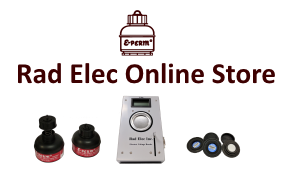
Rad Elec's Online Store is now open for business! Shop for your E-PERM® products at your convenience, at any time.
Spiking is an important part of any QA/QC plan, and is intended to ensure the accuracy of one's radon measurements when using passive detectors (such as Electret Ion Chambers). When you send in your detectors for spiking, we will expose them inside our radon chamber (which has a known radon concentration known as the "target value"), and then mail them back to you. It is your job to analyze the detectors, which will determine your accuracy (and bias) when compared to the known target value of Rad Elec's radon chamber.
Rad Elec's Spiking Service helps the user to detect potential inaccuracies with the passive detectors themselves, as well as to test the accuracy of users to analyze their own equipment and detectors correctly.
Both AARST-NRPP and the NRSB require that listed companies and individuals perform spiking measurements through an accredited radon chamber at a rate of 3 per 100 measurements, with a minimum of 3 per year and a maximum of 6 per month. However, even if nost listed, all organizations and individuals using passive detectors should send their detectors in for spiking to ensure the accuracy of their measurements.
The U.S. Environmental Protection Agency recommends that all organizations using passive devices expose, record and interpret the results of three spikes per 100 measurements (as averaged over the anticipated number of measurements during a several month period), with a minimum of three per year and a maximum (although more may be conducted) of six per month.
Yes! Rad Elec's radon chamber is NRSB-accredited as a tertiary radon chamber. Its accreditation identifier is #TRC6002.
You can find the Spiking Service Form right here.
The Spiking Service costs $20 per E-PERM® to be exposed in our radon chamber.
In the rare event that your results differ by more than 25% from Rad Elec's target value (the known radon concentration inside our radon chamber), then you should investigate the causes. It is not mandatory that you repeat the Spiking Test, since you are only required to perform Spiking measurements and investigate your results; in other words, there is no "passing" or "failing" a spiking test.
However, Rad Elec strongly encourages you to find out why this discrepancy exists -- typically, this may be caused due to the electret being accidentally touched during the initial or final voltage readings, or due to the presence of particulate and fibers on the electret surface. Sometimes this can be due to a filter inside one of your ionization chambers becoming loose. Always clean each chamber and electret prior to taking your initial readings, and you should find your results to be very close to our target.
To encourage our customers to discover the causes behind these discrepancies, Rad Elec offers free repeat spiking tests for detectors that exceed the ±25% control limit (apart from the shipping costs), if requested within 30 days of the initial test. Please remember to write "REPEAT" at the top of your Spiking Service Form, so that we can remember not to charge you for this repeat test.